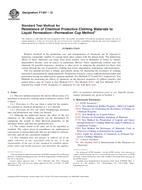We need your consent to use the individual data so that you can see information about your interests, among other things. Click "OK" to give your consent.
ASTM F1930-15
Standard Test Method for Evaluation of Flame Resistant Clothing for Protection Against Fire Simulations Using an Instrumented Manikin
STANDARD published on 1.2.2015
The information about the standard:
Designation standards: ASTM F1930-15
Note: WITHDRAWN
Publication date standards: 1.2.2015
SKU: NS-582807
The number of pages: 19
Approximate weight : 57 g (0.13 lbs)
Country: American technical standard
Category: Technical standards ASTM
The category - similar standards:
Annotation of standard text ASTM F1930-15 :
Keywords:
fire, flash, flame testing, flammability, textile, manikin, instrumented flammability testing, protective clothing, thermal testing,, ICS Number Code 13.340.10 (Protective clothing)
Additional information
| Significance and Use | ||||||||||||||||||||||||||||||||||||
|
5.1 Use this test method to measure the thermal protection provided by different materials, garments, clothing ensembles, and systems when exposed to a specified fire (see 3.2.2, 3.2.3, 4.1, and 10.4). 5.1.1 This test method does not simulate high radiant exposures, for example, those found in electric arc flash exposures, some types of fire exposures where liquid or solid fuels are involved, nor exposure to nuclear explosions. 5.2 This test method provides a measurement of garment and clothing ensemble performance on a stationary upright manikin of specified dimensions. This test method is used to provide predicted skin burn injury for a specific garment or protective clothing ensemble when exposed to a laboratory simulation of a fire. It does not establish a pass/fail for material performance. 5.2.1 This test method is not intended to be a quality assurance test. The results do not constitute a material’s performance specification. 5.2.2 The effects of body position and movement are not addressed in this test method. 5.3 The measurement of the thermal protection provided by clothing is complex and dependent on the apparatus and techniques used. It is not practical in a test method of this scope to establish details sufficient to cover all contingencies. Departures from the instructions in this test method have the potential to lead to significantly different test results. Technical knowledge concerning the theory of heat transfer and testing practices is needed to evaluate if, and which departures from the instructions given in this test method are significant. Standardization of the test method reduces, but does not eliminate, the need for such technical knowledge. Report any departures along with the results. |
||||||||||||||||||||||||||||||||||||
| 1. Scope | ||||||||||||||||||||||||||||||||||||
|
1.1 This test method is used to provide predicted human skin burn injury for single layer garments or protective clothing ensembles mounted on a stationary upright instrumented manikin which are then exposed in a laboratory to a simulated fire environment having controlled heat flux, flame distribution, and duration. The average exposure heat flux is 84 kW/m2 (2 cal/s•cm2), with durations up to 20 seconds. 1.2 The visual and physical changes to the single layer garment or protective clothing ensemble are recorded to aid in understanding the overall performance of the garment or protective clothing ensemble and how the predicted human skin burn injury results can be interpreted. 1.3 The skin burn injury prediction is based on a limited number of experiments where the forearms of human subjects were exposed to elevated thermal conditions. This forearm information for skin burn injury is applied uniformly to the entire body of the manikin, except the hands and feet. The hands and feet are not included in the skin burn injury prediction. 1.4 The measurements obtained and observations noted can only apply to the particular garment(s) or ensemble(s) tested using the specified heat flux, flame distribution, and duration. 1.5 This standard is used to measure and describe the response of materials, products, or assemblies to heat and flame under controlled conditions, but does not by itself incorporate all factors required for fire-hazard or fire risk assessment of the materials, products, or assemblies under actual fire conditions. 1.6 This method is not a fire-test-response test method. 1.7 The values stated in SI units are to be regarded as standard. The values given in parentheses are mathematical conversions to inch-pound units or other units commonly used for thermal testing. If appropriate, round the non-SI units for convenience. 1.8 This standard does not purport to address all of the safety concerns, if any, associated with its use. It is the responsibility of the user of this standard to establish appropriate safety and health practices and determine the applicability of regulatory limitations prior to use. 1.9 Fire testing is inherently hazardous. Adequate safeguards for personnel and property shall be employed in conducting these tests. |
||||||||||||||||||||||||||||||||||||
| 2. Referenced Documents | ||||||||||||||||||||||||||||||||||||
|
Similar standards:
Historical
1.2.2013
Historical
1.9.2012
Historical
1.6.2012
Historical
1.1.2013
Historical
15.2.2008
Historical
15.6.2008
We recommend:
Technical standards updating
Do you want to make sure you use only the valid technical standards?
We can offer you a solution which will provide you a monthly overview concerning the updating of standards which you use.
Would you like to know more? Look at this page.



 ASTM F1359/F1359M-13..
ASTM F1359/F1359M-13.. ASTM F1383-12e1
ASTM F1383-12e1 ASTM F1407-12
ASTM F1407-12 ASTM F1414-13
ASTM F1414-13 ASTM F1449-08
ASTM F1449-08 ASTM F1458-04(2008)..
ASTM F1458-04(2008)..
 Cookies
Cookies
